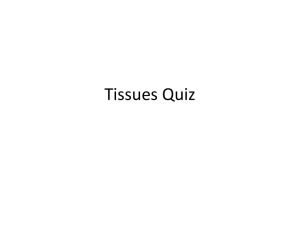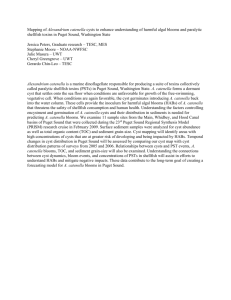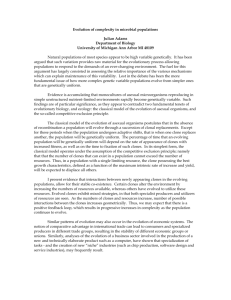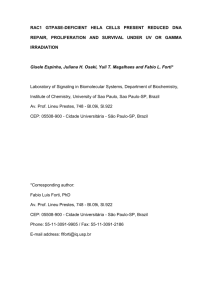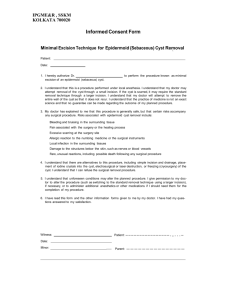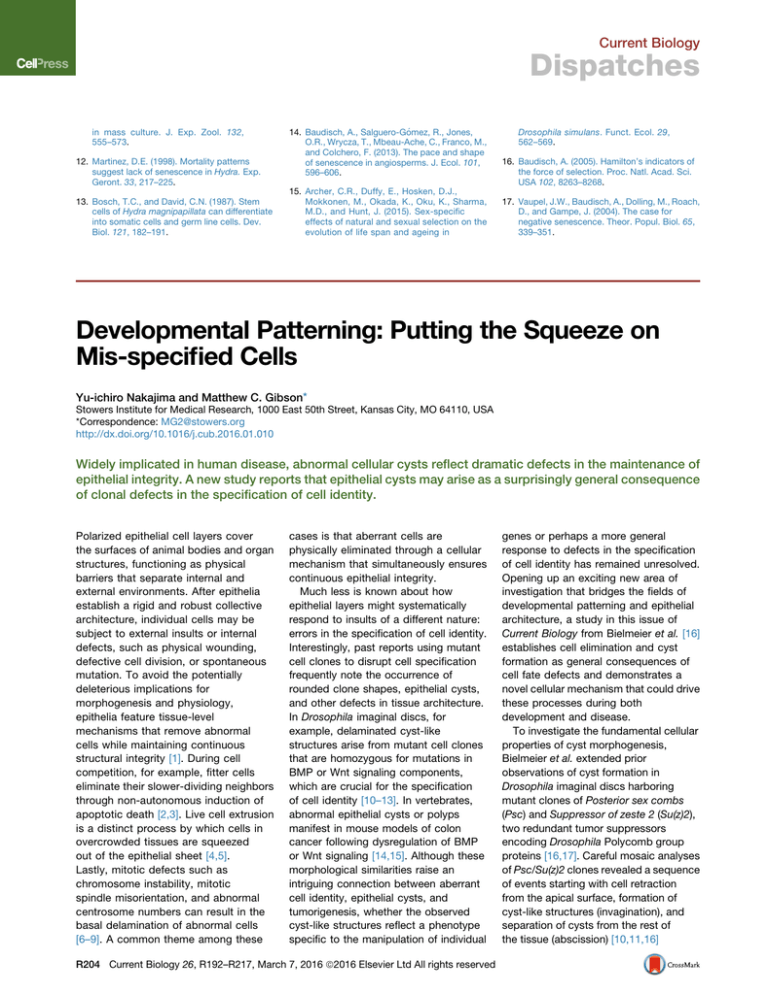
Current Biology
Dispatches
in mass culture. J. Exp. Zool. 132,
555–573.
12. Martinez, D.E. (1998). Mortality patterns
suggest lack of senescence in Hydra. Exp.
Geront. 33, 217–225.
13. Bosch, T.C., and David, C.N. (1987). Stem
cells of Hydra magnipapillata can differentiate
into somatic cells and germ line cells. Dev.
Biol. 121, 182–191.
14. Baudisch, A., Salguero-Gómez, R., Jones,
O.R., Wrycza, T., Mbeau-Ache, C., Franco, M.,
and Colchero, F. (2013). The pace and shape
of senescence in angiosperms. J. Ecol. 101,
596–606.
15. Archer, C.R., Duffy, E., Hosken, D.J.,
Mokkonen, M., Okada, K., Oku, K., Sharma,
M.D., and Hunt, J. (2015). Sex-specific
effects of natural and sexual selection on the
evolution of life span and ageing in
Drosophila simulans. Funct. Ecol. 29,
562–569.
16. Baudisch, A. (2005). Hamilton’s indicators of
the force of selection. Proc. Natl. Acad. Sci.
USA 102, 8263–8268.
17. Vaupel, J.W., Baudisch, A., Dolling, M., Roach,
D., and Gampe, J. (2004). The case for
negative senescence. Theor. Popul. Biol. 65,
339–351.
Developmental Patterning: Putting the Squeeze on
Mis-specified Cells
Yu-ichiro Nakajima and Matthew C. Gibson*
Stowers Institute for Medical Research, 1000 East 50th Street, Kansas City, MO 64110, USA
*Correspondence: MG2@stowers.org
http://dx.doi.org/10.1016/j.cub.2016.01.010
Widely implicated in human disease, abnormal cellular cysts reflect dramatic defects in the maintenance of
epithelial integrity. A new study reports that epithelial cysts may arise as a surprisingly general consequence
of clonal defects in the specification of cell identity.
Polarized epithelial cell layers cover
the surfaces of animal bodies and organ
structures, functioning as physical
barriers that separate internal and
external environments. After epithelia
establish a rigid and robust collective
architecture, individual cells may be
subject to external insults or internal
defects, such as physical wounding,
defective cell division, or spontaneous
mutation. To avoid the potentially
deleterious implications for
morphogenesis and physiology,
epithelia feature tissue-level
mechanisms that remove abnormal
cells while maintaining continuous
structural integrity [1]. During cell
competition, for example, fitter cells
eliminate their slower-dividing neighbors
through non-autonomous induction of
apoptotic death [2,3]. Live cell extrusion
is a distinct process by which cells in
overcrowded tissues are squeezed
out of the epithelial sheet [4,5].
Lastly, mitotic defects such as
chromosome instability, mitotic
spindle misorientation, and abnormal
centrosome numbers can result in the
basal delamination of abnormal cells
[6–9]. A common theme among these
cases is that aberrant cells are
physically eliminated through a cellular
mechanism that simultaneously ensures
continuous epithelial integrity.
Much less is known about how
epithelial layers might systematically
respond to insults of a different nature:
errors in the specification of cell identity.
Interestingly, past reports using mutant
cell clones to disrupt cell specification
frequently note the occurrence of
rounded clone shapes, epithelial cysts,
and other defects in tissue architecture.
In Drosophila imaginal discs, for
example, delaminated cyst-like
structures arise from mutant cell clones
that are homozygous for mutations in
BMP or Wnt signaling components,
which are crucial for the specification
of cell identity [10–13]. In vertebrates,
abnormal epithelial cysts or polyps
manifest in mouse models of colon
cancer following dysregulation of BMP
or Wnt signaling [14,15]. Although these
morphological similarities raise an
intriguing connection between aberrant
cell identity, epithelial cysts, and
tumorigenesis, whether the observed
cyst-like structures reflect a phenotype
specific to the manipulation of individual
R204 Current Biology 26, R192–R217, March 7, 2016 ª2016 Elsevier Ltd All rights reserved
genes or perhaps a more general
response to defects in the specification
of cell identity has remained unresolved.
Opening up an exciting new area of
investigation that bridges the fields of
developmental patterning and epithelial
architecture, a study in this issue of
Current Biology from Bielmeier et al. [16]
establishes cell elimination and cyst
formation as general consequences of
cell fate defects and demonstrates a
novel cellular mechanism that could drive
these processes during both
development and disease.
To investigate the fundamental cellular
properties of cyst morphogenesis,
Bielmeier et al. extended prior
observations of cyst formation in
Drosophila imaginal discs harboring
mutant clones of Posterior sex combs
(Psc) and Suppressor of zeste 2 (Su(z)2),
two redundant tumor suppressors
encoding Drosophila Polycomb group
proteins [16,17]. Careful mosaic analyses
of Psc/Su(z)2 clones revealed a sequence
of events starting with cell retraction
from the apical surface, formation of
cyst-like structures (invagination), and
separation of cysts from the rest of
the tissue (abscission) [10,11,16]
Current Biology
Dispatches
(Figure 1A). Because Polycomb proteins
epigenetically silence factors that control
cellular identity, altered cell fates could
induce cyst formation. Indeed, ectopic
expression of transcription factors that
are normally repressed by Psc/Su(z)2
was sufficient to drive cyst formation.
Moreover, cyst morphogenesis appears
to be a common consequence of clonally
altering cell fates. As with disruption of
BMP and Wnt, altered Hedgehog or
JAK/STAT signaling also resulted in the
generation of cysts. Combined, these
results indicate that abnormal cyst
formation is a general response to cell fate
mis-specification.
What is a conceivable general
mechanism underlying a similar process
of cyst formation in mis-specified cell
clones of multiple distinct genotypes?
Arguing against the more intuitive
possibility of autonomous cell shape
defects [18], Bielmeier et al. [16]
discovered that wild-type cells also form
cysts when surrounded by mis-specified
cells. These results demonstrate that cyst
formation is a clone-non-autonomous
process driven by the apposition of
cells with different fates. Accordingly,
the authors turned their focus to
understanding events at the boundary
between wild-type and mis-specified
cells. Here, they found an enrichment of
filamentous actin at the clone–non-clone
interface, both at the level of adherens
junctions and throughout the basolateral
domain. Further, myosin, moesin, and
their phospho-activated forms also
accumulated specifically at the interface
between wild-type and mis-specified
cells. Consistent with a postulated local
increase in actomyosin contractility, misspecified cell clones exhibited striking
shape changes, including basement
membrane deformation and minimization
of lateral contacts. Although the
functional significance of the localized
actomyosin machinery has yet to be
tested, these observations implicate
interface contractility as a likely
mechanical force that drives cyst
formation.
To address whether interface
contractility is sufficient to induce cysts,
Bielmeier et al. [16] next performed
computer simulations using a new 3D
vertex model. The authors analyzed
the epithelial deformation under different
conditions, taking into account cell
A
Cyst formation
B
Single cell elimination
Invagination
Apical constriction
Abscission
Apoptosis
Current Biology
Figure 1. Interface contractility between differently fated cells induces cyst formation or
single cell elimination depending on clone size.
At the interface between cells of different fates (shown as yellow and gray), contractility emerges and
becomes a physical force (red arrows). Interface contractility is sufficient for cyst formation in the case
of intermediate size clones (A) or leads to the elimination of single cells via apoptosis (B). Magenta,
adherens junctions; green, septate junctions; blue, nuclei.
volumes as well as apical and basal
surfaces. By increasing the apical line
tension and lateral surface tension,
clones of simulated mis-specified cells
recapitulated the process of cyst
morphogenesis. When tension was
increased in all mis-specified cells
(referred to as bulk contractility),
in silico cyst formation was still observed.
However, inverse clusters of wildtype cells did not form cysts when
bulk contractility was modeled in
surrounding mis-specified cells.
Critically, experiments confirmed the
results of these simulations. Induction
of bulk contractility by expression of an
activated form of the Rho GTPase
caused cyst formation, which was not
observed in wild-type cells surrounded
by actively contracting cells. Together,
the combined in silico and in vivo results
suggest that cyst formation is triggered
by interface contractility at the boundary
between cell populations with different
fates.
Based on their simulations, Bielmeier
et al. [16] further hypothesized that
the final clonal morphology should
depend on cell number. This idea was
evaluated by applying a continuum
theory of tissue mechanics, wherein
epithelial sheet buckling can be
explained by two factors: first, that large
clones are subject to less boundary
pressure; and second, that small clones
have a higher resistance to buckling.
By this logic, only intermediate size
clones should undergo cyst formation.
To test this hypothesis, the authors
examined the relationship between
Current Biology 26, R192–R217, March 7, 2016 ª2016 Elsevier Ltd All rights reserved R205
Current Biology
Dispatches
clone size and shape by quantifying
shape parameters, such as clone
widths and clone deformations,
and they confirmed that maximal cell
shape changes were correlated with
intermediate size clones (composed
of approximately 70 cells). The 3D
vertex model simulations also
provided insight into the physical
forces that could explain experimental
measurements. By determining the
minimum requirements for interface
contractility, the authors concluded
that a threefold increase in both apical
line and lateral surface tensions would
account for the experimental results,
supporting their observations of
interfacial actomyosin enrichment at
both adherens junctions and lateral
cell–cell contacts.
Interestingly, small clones of misspecified cells did not form cysts but
instead exhibited a wedge-like
morphology [16] that has also been
observed during apical constriction
[19] and apoptotic cell extrusion [5]
(Figure 1B). To determine whether small
mis-specified cell clones were ultimately
eliminated from the epithelium,
Bielmeier et al. [16] quantified the
frequency of clones of different sizes
and inferred that clones with fewer than
six cells were subject to elimination.
Furthermore, cells in small clones
underwent apoptosis more frequently
than those in larger clones. Inhibition of
apoptosis by DIAP1 rescued the clones
consisting of two to six cells, but it did
not prevent the loss of single cell clones.
This result suggests that single misspecified cells can sense strong
apoptotic stimuli, correlating with
interface contractility. Importantly, small
clones of wild-type cells surrounded by
mis-specified cells were also eliminated
by apoptosis, suggesting that interface
contractility, not cell-autonomous
effects, triggers the extrusion and death
of small cell clusters.
By fusing experimental and theoretical
approaches, this study illuminates an
intriguing new aspect of epithelial
homeostasis. The experiments on clone
size also highlight the potential nature of
interface contractility as a double-edged
sword that efficiently eliminates aberrant
single cells but also drives abnormal
cyst formation in larger cell clones
(Figure 1) [16]. These results have
interesting developmental and
biomedical implications, particularly
under circumstances in which cells
acquire mutations that suppress
apoptosis. In one case consistent with
this idea, oncogenic Ras expression in
the wing disc induces cyst formation
[16,20], probably because Ras signaling
simultaneously alters cell fate and
suppresses apoptosis, conferring a
better chance of cystic growth. Given
that clones homozygous for tumor
suppressor mutants or overexpressing
oncogenes induce cyst formation,
abnormal epithelial cysts could be a
general structural hallmark of early stage
tumorigenesis. Looking ahead, future
studies should focus on the molecular
mechanism by which epithelial cells are
able to detect sharp discontinuities in
cell identity and transmit this information
to the relevant cytoskeletal effectors. It
will also be critical to gain more detailed
mechanistic insights into the generation
of interface contractility through
cytoskeletal dynamics. On the whole
this report lays a solid foundation for
investigating new mechanisms of
epithelial homeostasis and cyst
formation in vivo, with strong
implications for our understanding of
development, morphogenesis, and
disease.
REFERENCES
1. Macara, I.G., Guyer, R., Richardson, G., Huo,
Y., and Ahmed, S.M. (2014). Epithelial
homeostasis. Curr. Biol. 24, R815–R825.
2. Vincent, J.P., Fletcher, A.G., and BaenaLopez, L.A. (2013). Mechanisms and
mechanics of cell competition in epithelia. Nat.
Rev. Mol. Cell Biol. 14, 581–591.
3. Levayer, R., and Moreno, E. (2013).
Mechanisms of cell competition: themes and
variations. J. Cell Biol. 200, 689–698.
4. Eisenhoffer, G.T., and Rosenblatt, J. (2013).
Bringing balance by force: live cell extrusion
controls epithelial cell numbers. Trends Cell
Biol. 23, 185–192.
architecture by directing planar spindle
orientation. Nature 500, 359–362.
8. Poulton, J.S., Cuningham, J.C., and Peifer, M.
(2014). Acentrosomal Drosophila epithelial
cells exhibit abnormal cell division, leading to
cell death and compensatory proliferation.
Dev. Cell 30, 731–745.
9. Sabino, D., Gogendeau, D., Gambarotto, D.,
Nano, M., Pennetier, C., Dingli, F., Arras, G.,
Loew, D., and Basto, R. (2015). Moesin is a
major regulator of centrosome behavior in
epithelial cells with extra centrosomes. Curr.
Biol. 25, 879–889.
10. Gibson, M.C., and Perrimon, N. (2005).
Extrusion and death of DPP/BMPcompromised epithelial cells in the
developing Drosophila wing. Science 307,
1785–1789.
11. Shen, J., and Dahmann, C. (2005). Extrusion of
cells with inappropriate Dpp signaling from
Drosophila wing disc epithelia. Science 307,
1789–1790.
12. Widmann, T.J., and Dahmann, C. (2009).
Wingless signaling and the control of cell
shape in Drosophila wing imaginal discs. Dev.
Biol. 334, 161–173.
13. Zimmerman, S.G., Thorpe, L.M., Medrano,
V.R., Mallozzi, C.A., and McCartney, B.M.
(2010). Apical constriction and invagination
downstream of the canonical Wnt signaling
pathway require Rho1 and Myosin II. Dev. Biol.
340, 54–66.
14. Batlle, E., Henderson, J.T., Beghtel, H., van
den Born, M.M., Sancho, E., Huls, G., Meeldijk,
J., Robertson, J., van de Wetering, M.,
Pawson, T., et al. (2002). Beta-catenin and TCF
mediate cell positioning in the intestinal
epithelium by controlling the expression of
EphB/ephrinB. Cell 111, 251–263.
15. Haramis, A.P., Begthel, H., van den Born, M.,
van Es, J., Jonkheer, S., Offerhaus, G.J., and
Clevers, H. (2004). De novo crypt formation
and juvenile polyposis on BMP inhibition in
mouse intestine. Science 303, 1684–1686.
16. Bielmeier, C., Alt, S., Weichselberger, V.,
La Fortezza, M., Harz, H., Jülicher, F.,
Salbreux, G., and Classen, A.-K. (2016).
Interface contractility between differently fated
cells drives cell elimination and cyst formation.
Curr. Biol. 26, 563–574.
17. Classen, A.K., Bunker, B.D., Harvey, K.F.,
Vaccari, T., and Bilder, D. (2009). A tumor
suppressor activity of Drosophila Polycomb
genes mediated by JAK-STAT signaling. Nat.
Genet. 41, 1150–1155.
5. Gu, Y., and Rosenblatt, J. (2012). New
emerging roles for epithelial cell extrusion.
Curr. Opin. Cell Biol. 24, 865–870.
18. Widmann, T.J., and Dahmann, C. (2009). Dpp
signaling promotes the cuboidal-to-columnar
shape transition of Drosophila wing disc
epithelia by regulating Rho1. J. Cell Sci. 122,
1362–1373.
6. Dekanty, A., Barrio, L., Muzzopappa, M., Auer,
H., and Milan, M. (2012). Aneuploidy-induced
delaminating cells drive tumorigenesis in
Drosophila epithelia. Proc. Natl. Acad. Sci.
USA 109, 20549–20554.
19. Sawyer, J.M., Harrell, J.R., Shemer, G.,
Sullivan-Brown, J., Roh-Johnson, M., and
Goldstein, B. (2010). Apical constriction: a cell
shape change that can drive morphogenesis.
Dev. Biol. 341, 5–19.
7. Nakajima, Y., Meyer, E.J., Kroesen, A.,
McKinney, S.A., and Gibson, M.C. (2013).
Epithelial junctions maintain tissue
20. Bell, G.P., and Thompson, B.J. (2014).
Colorectal cancer progression: lessons from
Drosophila? Semin. Cell Dev. Biol. 28, 70–77.
R206 Current Biology 26, R192–R217, March 7, 2016 ª2016 Elsevier Ltd All rights reserved

